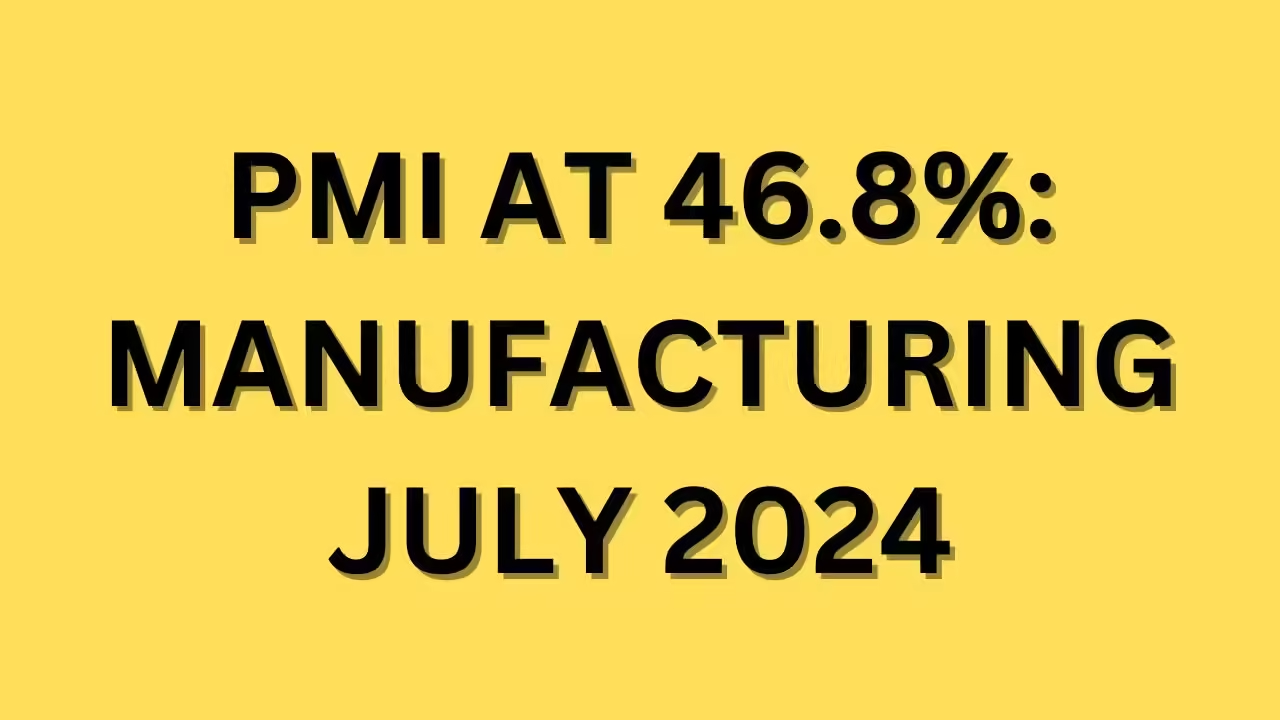The July 2024 Manufacturing ISM Report On Business reveals a concerning picture for the U.S. manufacturing sector. The Purchasing Managers’ Index (PMI) fell to 46.8%, indicating a contraction in manufacturing activity. This report, compiled by the Institute for Supply Management (ISM), highlights several key components: new orders, backlogs, production, employment, supplier deliveries, and raw material inventories. Each of these areas presents a nuanced view of the challenges currently facing the manufacturing industry.
Understanding the PMI and Its Implications
The PMI is a key indicator used to gauge the economic health of the manufacturing sector. It is derived from a survey of purchasing managers and supply executives across various industries. A PMI above 50% generally indicates expansion, while a reading below 50% suggests contraction. The July 2024 figure of 46.8% marks a significant decline, reflecting reduced business activity and potential economic slowdowns.
New Orders and Backlogs: A Declining Trend
One of the most alarming aspects of the July report is the continued contraction in new orders and backlogs. The new orders index, a critical component of the PMI, dropped significantly, suggesting weakening demand for manufactured goods. This decline could be attributed to various factors, including reduced consumer spending, economic uncertainty, and global trade tensions. The backlog of orders also shrank, indicating that companies are not only receiving fewer new orders but are also rapidly clearing their existing orders, potentially due to decreased future demand expectations.
The reduction in new orders and backlogs is particularly concerning because these metrics are often considered leading indicators of future manufacturing activity. A sustained decline in new orders can lead to further cuts in production, employment, and overall economic output.
Production and Employment: Contraction Continues
The production index, another critical measure in the PMI, also showed contraction, mirroring the overall decline in new orders. Manufacturers have been scaling back production in response to falling demand, as indicated by the decreasing new orders. This reduction in output can have a cascading effect on the broader economy, impacting everything from supply chains to job markets.
Employment in the manufacturing sector has been similarly affected. The employment index showed a continued contraction, indicating that manufacturers are either reducing their workforce or are cautious about hiring new employees. This trend is a reflection of the broader uncertainty in the market, as companies hesitate to expand their labor force amid declining demand and uncertain economic conditions.
The contraction in employment not only affects the manufacturing sector but also has broader implications for the labor market and economic health. Reduced manufacturing jobs can lead to lower consumer spending, further exacerbating economic slowdowns.
Supplier Deliveries: Slowing Down
An interesting aspect of the report is the index for supplier deliveries, which slowed down, indicating longer delivery times. Typically, slower supplier deliveries are seen in an expanding economy, where high demand leads to supply chain bottlenecks. However, in this context, the slowing deliveries are more likely due to disruptions in the supply chain and logistical challenges rather than increased demand.
Global supply chain issues have been a recurring theme, with factors such as geopolitical tensions, trade restrictions, and logistical bottlenecks contributing to delays. These disruptions can cause significant challenges for manufacturers, who rely on timely deliveries of raw materials and components to maintain production schedules.
Raw Materials Inventories: A Mixed Signal
The report also notes changes in raw material inventories. While some companies reported an increase in inventories, others noted a decline. This mixed signal could be a result of various factors. Companies with rising inventories might be experiencing slower-than-expected sales, leading to an accumulation of unsold goods. On the other hand, those with declining inventories might be struggling with supply chain issues, unable to secure sufficient raw materials to meet their production needs.
Managing raw material inventories is a delicate balance for manufacturers. Excessive inventories can lead to increased holding costs and potential waste, while insufficient inventories can disrupt production and lead to missed opportunities. The current mixed trends in inventory levels highlight the challenges manufacturers face in navigating an uncertain economic environment.
Sectoral Analysis and Outlook
The July 2024 Manufacturing ISM Report On Business reflects a challenging period for the manufacturing sector. The contraction across key indices—new orders, production, employment, and supplier deliveries—points to a broader economic slowdown. Several sectors within manufacturing, such as automotive, electronics, and heavy machinery, have been particularly hard-hit by these trends.
The automotive sector, for instance, has faced declining sales and production cuts due to both demand-side issues and supply chain disruptions, particularly in semiconductor supplies. Similarly, the electronics industry has been grappling with component shortages, impacting production timelines and order fulfillment.
The outlook for the manufacturing sector remains uncertain. Several external factors, such as geopolitical tensions, trade policies, and global economic conditions, continue to pose risks. Additionally, the ongoing challenges related to supply chain disruptions and inflationary pressures on raw materials could further impact manufacturing output and profitability.
However, it’s worth noting that some positive signs could emerge if there is stabilization in global supply chains or a rebound in consumer demand. Government policies aimed at boosting infrastructure spending or providing incentives for manufacturing could also play a crucial role in reviving the sector.
Conclusion: Manufacturing ISM Report On Business
The July 2024 Manufacturing ISM Report On Business paints a sobering picture of the U.S. manufacturing sector, with the PMI at 46.8% indicating contraction. Key areas such as new orders, backlogs, production, and employment are all experiencing downturns, while supplier deliveries are slowing, and raw material inventories show mixed signals.
These trends suggest a challenging environment for manufacturers, driven by weakening demand, supply chain disruptions, and broader economic uncertainties. As the industry navigates these challenges, it will be crucial for businesses and policymakers alike to focus on strategies that can stabilize and potentially revitalize the sector.
In conclusion, the current state of the manufacturing industry underscores the need for resilience and adaptability. Companies must continue to innovate, manage costs, and seek new opportunities to maintain their competitive edge in a complex and dynamic global market. The coming months will be critical in determining whether the sector can reverse its current contraction and return to a path of growth and stability.



